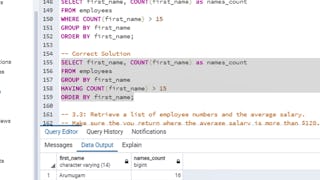In this project you will use MySQL Workbench to write SQL queries that aggregate (group) data. Incorporating aggregate functions like COUNT, SUM, and AVG, your SQL queries will group and summarize data. Data that is aggregated and presented in a logical format makes it a more valuable decision-making tool for users.

Enjoy unlimited growth with a year of Coursera Plus for $199 (regularly $399). Save now.

Recommended experience
What you'll learn
Recognize ways in which aggregated data can improve the decision-making process.
Incorporate the GROUP BY clause in SQL to aggregate data.
Demonstrate the use of SQL aggregate functions using MySQL Workbench.
Skills you'll practice
Details to know

Add to your LinkedIn profile
Only available on desktop
See how employees at top companies are mastering in-demand skills

Learn, practice, and apply job-ready skills in less than 2 hours
- Receive training from industry experts
- Gain hands-on experience solving real-world job tasks
- Build confidence using the latest tools and technologies

About this Guided Project
Learn step-by-step
In a video that plays in a split-screen with your work area, your instructor will walk you through these steps:
Examine and execute an SQL query that uses the Group and Count functions in MySQL Workbench to count the number of orders placed by each customer.
Group by customer and product name and use the SQL COUNT aggregate function to display the total number of items on each order for each customer.
After calculating the amount due for each product, use the SQL SUM aggregate function and the GROUP BY clause to calculate the total sales amount for each order.
Write SQL code in MySQL Workbench that incorporates the Group, Count, Min, Max, and Avg functions to produce statistics for analyzing purchasing patterns.
Group by customer and order, using the HAVING clause to filter for orders with more than one item per order.
Recommended experience
Familiarity with the MySQL Workbench user interface and the SQL SELECT statement are recommended.
5 project images
Instructor

Offered by
How you'll learn
Skill-based, hands-on learning
Practice new skills by completing job-related tasks.
Expert guidance
Follow along with pre-recorded videos from experts using a unique side-by-side interface.
No downloads or installation required
Access the tools and resources you need in a pre-configured cloud workspace.
Available only on desktop
This Guided Project is designed for laptops or desktop computers with a reliable Internet connection, not mobile devices.
Why people choose Coursera for their career




You might also like

Open new doors with Coursera Plus
Unlimited access to 10,000+ world-class courses, hands-on projects, and job-ready certificate programs - all included in your subscription
Advance your career with an online degree
Earn a degree from world-class universities - 100% online
Join over 3,400 global companies that choose Coursera for Business
Upskill your employees to excel in the digital economy
Frequently asked questions
By purchasing a Guided Project, you'll get everything you need to complete the Guided Project including access to a cloud desktop workspace through your web browser that contains the files and software you need to get started, plus step-by-step video instruction from a subject matter expert.
Because your workspace contains a cloud desktop that is sized for a laptop or desktop computer, Guided Projects are not available on your mobile device.
Guided Project instructors are subject matter experts who have experience in the skill, tool or domain of their project and are passionate about sharing their knowledge to impact millions of learners around the world.





